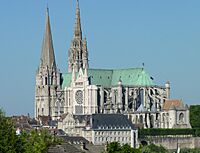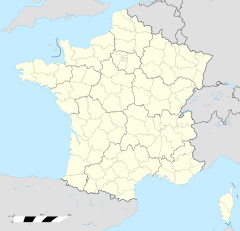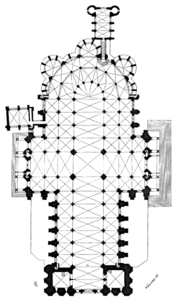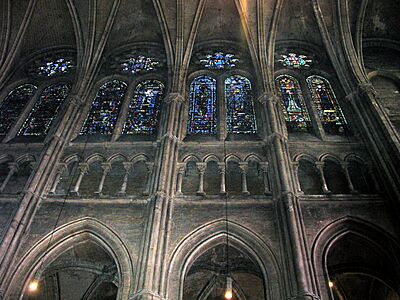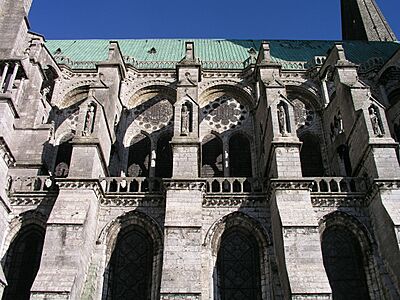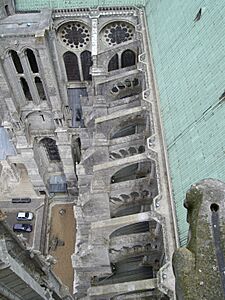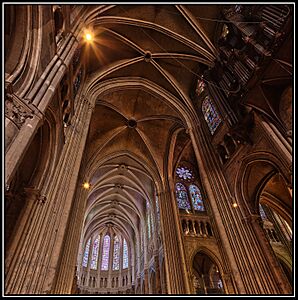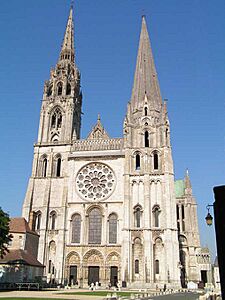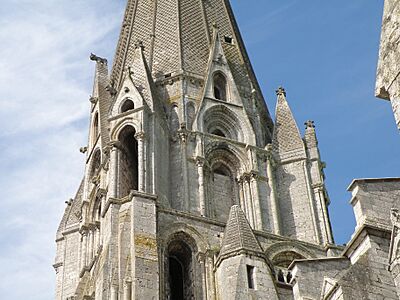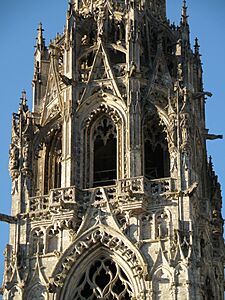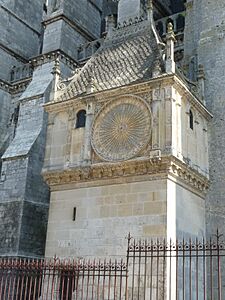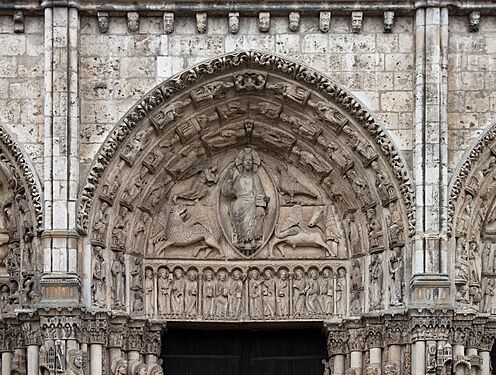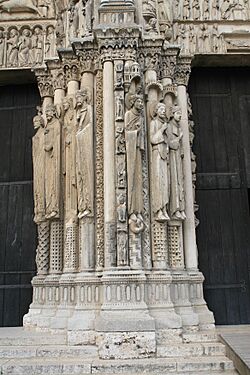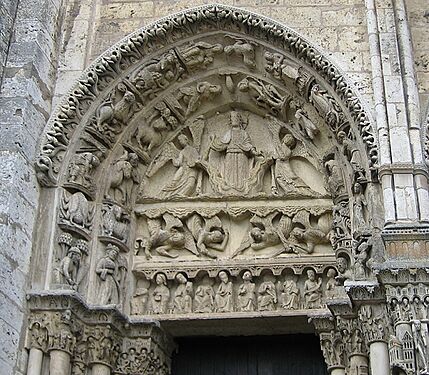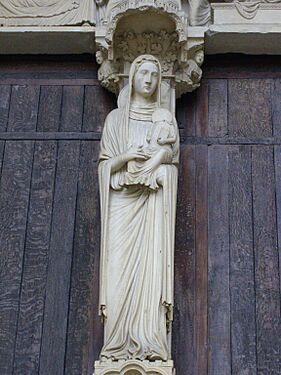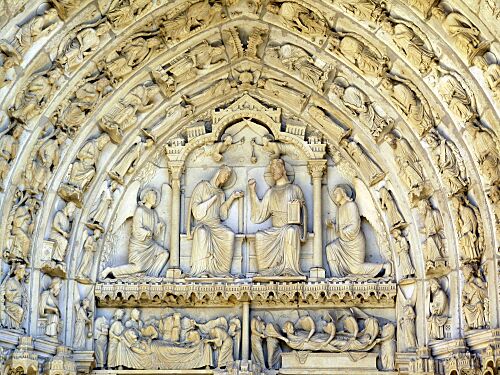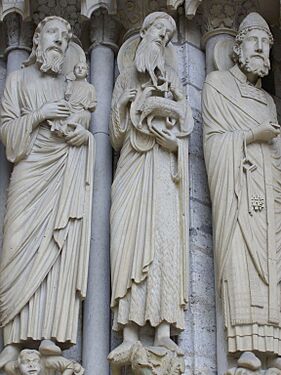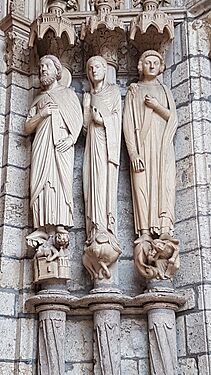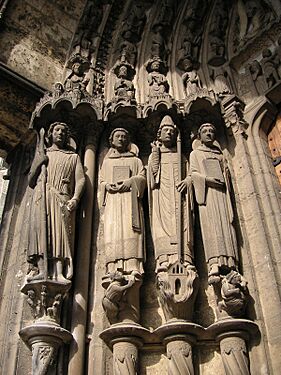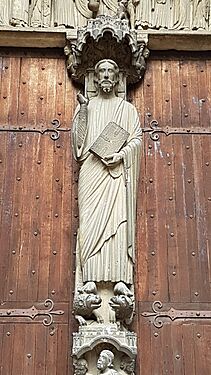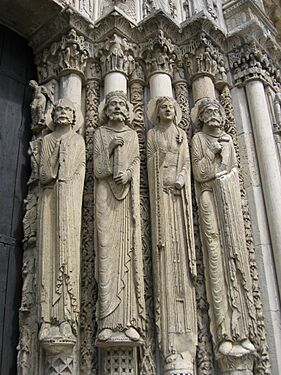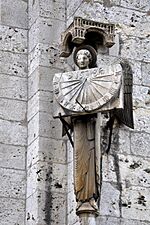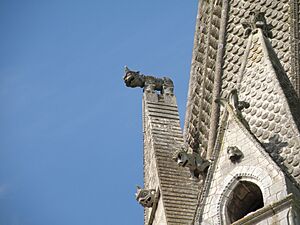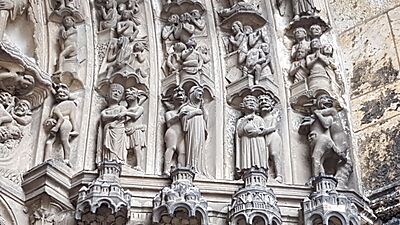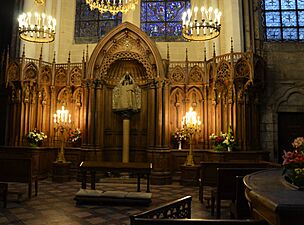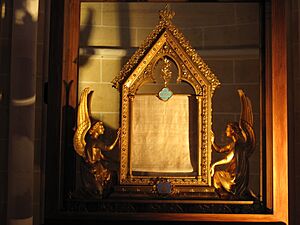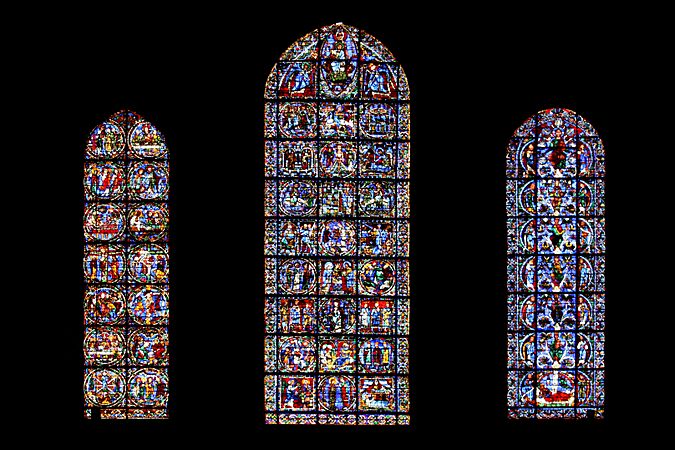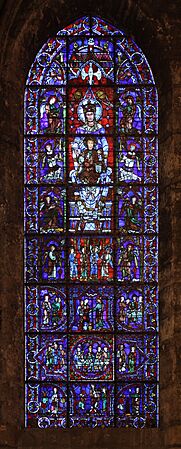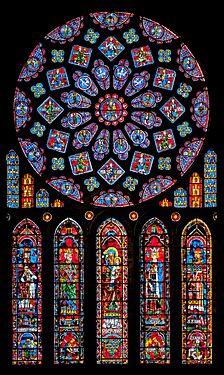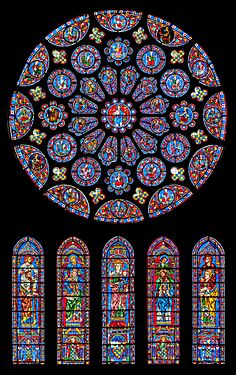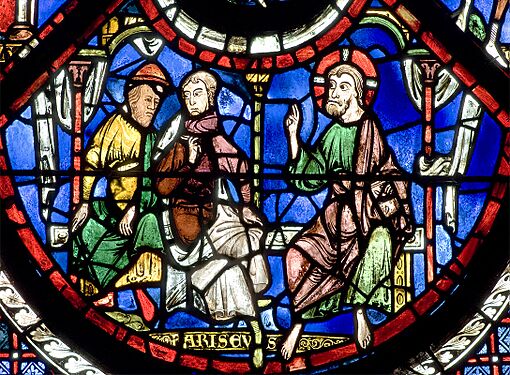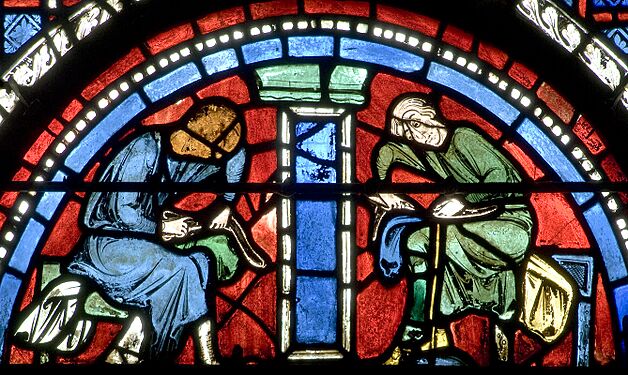Chartres Cathedral facts for kids
Quick facts for kids Chartres Cathedral |
|
|---|---|
|
Cathédrale Notre-Dame de Chartres
|
|
|
Chartres Cathedral
|
|
| Religion | |
| Affiliation | Catholic Church |
| Province | Diocese of Chartres |
| Rite | Roman |
| Ecclesiastical or organizational status | Cathedral |
| Status | Active |
| Location | |
| Location | 16 Cloître Notre Dame, 28000 Chartres, France |
| Architecture | |
| Architectural type | Church |
| Architectural style | French Gothic, Romanesque, High Gothic |
| Groundbreaking | 1126 (Romanesque) 1194 (Gothic) |
| Completed | 1252 |
| Website | |
| UNESCO World Heritage Site | |
| Criteria | Cultural: i, ii, iv |
| Inscription | 1979 (3rd Session) |
|
Monument historique
|
|
| Official name | cathédrale Notre-Dame, Chartres |
| Designated | 1862 |
| Reference no. | IA28000005 |
Chartres Cathedral (French: Cathédrale Notre-Dame de Chartres) is a famous Catholic church in Chartres, France. It is about 80 kilometers southwest of Paris. This amazing building is the main church for the Diocese of Chartres, which is led by a bishop.
Most of the cathedral was built between 1194 and 1220. It stands where at least five earlier churches have been since the 300s. Chartres Cathedral is known as one of the best examples of Gothic architecture. It was built on top of older Romanesque parts. Its north spire was added later, between 1507 and 1513, in a more decorative style.
In 1979, UNESCO named it a World Heritage Site. They called it a "masterpiece" and a "high point of French Gothic art." The cathedral has been kept in great condition. Most of its original stained glass windows are still there. The building's design has changed very little since the early 1200s.
The outside of the cathedral has large flying buttresses. These supports allowed builders to make the windows much bigger. The front of the cathedral has two spires that look different. One is a plain pyramid from around 1160, about 105 meters tall. The other is a more decorative spire from the late Gothic period, about 113 meters tall. The cathedral's three main entrances have hundreds of carved figures. These sculptures show important religious stories and ideas.
For hundreds of years, Chartres Cathedral has been a popular place for visitors. Many Christian pilgrims come to see a special relic. This relic is the Sancta Camisa, believed to be a tunic worn by the Virgin Mary when Jesus was born. Many tourists also visit to admire the cathedral's beautiful architecture and art. A special statue of the Black Madonna inside was honored by Pope Pius IX in 1855.
Contents
- History of Chartres Cathedral
- Timeline of Chartres Cathedral
- Exploring Chartres Cathedral
- Stained Glass Windows
- The Crypt
- Choir Wall and Organ
- The Labyrinth
- Gardens and Other Buildings
- Building the Cathedral
- Restoration Work
- The School of Chartres
- Life Around the Cathedral
- Pilgrimages and the Sancta Camisa
- Chartres Light Celebration
- See also
History of Chartres Cathedral
Early Churches and Fires
Over time, at least five churches have stood on this spot. Each one was built after an earlier church was damaged by war or fire. The first church here was from the 300s. It was burned down in 743. The second church was set on fire by Danish pirates in 858. It was rebuilt but then destroyed by fire again in 1020. A small part of this old church, called Saint Lubin Chapel, is still under the main part of the cathedral today.
After the big fire in 1020, Bishop Fulbert decided to build a new cathedral. He asked for help from kings and queens across Europe. He received many gifts, even from Cnut the Great, who was King of Norway, Denmark, and England. The new cathedral was built on top of the old church's remains. It had a special walkway around a chapel, with three large chapels that still exist today.
In 1134, another fire in the town damaged the front of the cathedral and its bell tower. Construction began on the north tower in the 1120s. The south tower started around 1144. The famous Royal Portal sculptures were added to the south tower's walls. The south tower was finished around 1165. It reached 105 meters, making it one of the tallest in Europe at the time.
Rebuilding After the 1194 Fire
On June 10, 1194, a huge fire destroyed most of the cathedral. Only the crypt (underground area), the towers, and the front entrance survived. The cathedral was already famous for its relics of the Virgin Mary. People from all over Europe sent money to help rebuild it.
Reconstruction started right away. The parts that survived, like the two towers and the Royal Portal, were used in the new design. The main part of the church (nave), side aisles, and lower parts of the transepts (cross-shaped sections) were built first. Then came the choir and chapels. By 1220, the roof was in place. Most of the new cathedral, with its stained glass and sculptures, was finished in just 25 years. This was incredibly fast for that time! The cathedral was officially opened again in October 1260. King Louis IX of France was there for the ceremony.
Later Changes and Important Events
Not many big changes were made after the 1200s. In 1326, a new chapel for Saint Piatus of Tournai was added. Another chapel was opened in 1417 by Louis, Count of Vendôme. This chapel has a very fancy Flamboyant Gothic style.
In 1506, lightning struck the north spire and destroyed it. Architect Jean Texier rebuilt it between 1507 and 1513 in the decorative Flamboyant style.
On February 27, 1594, King Henri IV of France was crowned in Chartres Cathedral. This was unusual because French kings were usually crowned in Reims Cathedral. But at that time, Reims was not safe.
In 1753, some changes were made inside to update the church. Stone pillars were covered, and some stained glass was replaced with clearer windows. This made the main altar brighter.
French Revolution and 1800s
During the French Revolution, a group tried to destroy the sculptures on the north porch. But local people stopped them. A plan to blow up the cathedral was also stopped by an architect. He said the rubble would block the streets for years. The cathedral became property of the French government. It was not damaged further.
In 1836, a fire destroyed the wooden roof. But the main structure and stained glass were safe. The old roof was replaced with a new one made of iron and covered with copper.
Saving the Cathedral in World War II
During World War II, in August 1944, American soldiers thought the cathedral's towers might be used by German artillery as an observation post. They were ordered to target the cathedral.
However, American Colonel Welborn Griffith questioned this order. He went with another soldier to check if Germans were really using the towers. Griffith found the cathedral empty. He then had the church bells ring as a signal for the Americans not to shoot. The American command heard the bells and canceled the attack. Colonel Griffith died in combat later that day. He was honored with many awards for saving the cathedral.
Recent Restoration Work
From 1997 to 2018, a big restoration project took place. The inside and outside of the cathedral were cleaned. The stained glass was protected with a special coating. The inside walls were cleaned and painted white, yellow, and beige. This was done to make it look more like it did in the 1200s. This restoration caused some debate, but it helped protect the building from crumbling.
Daily Life at the Cathedral
The cathedral is still the main church for the Bishop of Chartres. Every evening since 2001, a special evening prayer service called Vespers is sung by the Chemin Neuf Community.
Timeline of Chartres Cathedral
- 743 – First mention of a church in Chartres.
- c. 876 – Charles the Bald gives the cathedral a special relic, the veil of the Virgin Mary. This makes it a pilgrimage site.
- 1020 – Fire damages the cathedral. Bishop Fulbert starts rebuilding.
- 1030 – New cathedral is officially opened.
- 1134 – Construction of the Royal Portal begins.
- 1170 – South bell tower is finished.
- 1194 – A major fire destroys much of the city and most of the cathedral. Rebuilding starts right away.
- 1221 – New vaulted ceilings are completed.
- 1210–1250 – Many stained glass windows are installed.
- 1260 – The new cathedral is officially opened with King Louis IX present.
- 1324–1353 – The chapel of Saint Piat is built.
- 1417 – Chapel of the Annunciation is completed.
- 1507–1513 – The north tower is rebuilt in a fancy Flamboyant Gothic style after being damaged by fire.
- 1594 – King Henry IV of France is crowned in Chartres.
- 1792 – During the French Revolution, the church's treasures are taken.
- 1802 – The church is given back to the Catholic Church.
- 1836 – Fire destroys the roof. It is replaced with a metal structure.
- 1840 – Cathedral is named a national historical monument.
- 1908 – Cathedral is given the special status of a basilica.
- 1979 – Cathedral is declared a UNESCO World Heritage Site.
- 1994 – Cathedral celebrates 800 years since its main rebuilding.
- 2009 – A new restoration project begins, cleaning and repainting the walls.
Exploring Chartres Cathedral
Key Facts and Figures
- Length: 130 meters (about 426 feet)
- Width: 32 meters (about 105 feet) at the nave, 46 meters (about 151 feet) at the transepts
- Nave height: 37 meters (about 121 feet)
- Total area: 10,875 square meters (about 117,000 square feet)
- South-west tower height: 105 meters (about 345 feet)
- North-west tower height: 113 meters (about 371 feet)
- Number of stained-glass windows: 167
- Choir enclosure: 200 statues in 41 scenes
Building Plan and Flying Buttresses
-
Chartres floorplan (1856) by Eugène Viollet-le-Duc
The cathedral's shape is like a cross, which is common for Gothic cathedrals. Its design was influenced by the older Romanesque church underneath it. The most important new feature was the use of flying buttresses. These are strong stone supports that lean against the outside walls. They push against the walls, balancing the outward force from the heavy stone ceilings inside. This allowed builders to make the walls thinner and much taller. It also created more space for huge windows.
Chartres was one of the first cathedrals to use flying buttresses in this way. This design was so successful that other famous cathedrals, like Amiens Cathedral and Reims Cathedral, copied it. Inside, the main pillars are also special. They are made of alternating round and octagonal shapes. This design, called pilier cantonné, is strong and elegant. It helped support the large stained glass windows high up in the church.
The Towers and Clock
The two towers of Chartres Cathedral were built at different times and look different. The north tower was started in 1134. It was rebuilt in a very decorative style between 1507 and 1513 by architect Jean Texier. This style is called Flamboyant Gothic, and it has many fancy carvings and points. This tower is 113 meters tall.
The south tower was started around 1144 and finished in 1150. It is 105 meters tall and has a simpler, older Gothic design. Both towers survived the big fire of 1194.
At the base of the north tower, there is a small building with a special 24-hour astronomical clock. It was built in 1520 by Jean Texier. The clock face is very large, about 5.5 meters (18 feet) across.
The Portals and Their Sculptures
The cathedral has three main entrances, called portals. These are on the west side and on the north and south transepts. They are covered in amazing sculptures. These carvings tell stories from the Bible and explain religious ideas. They were important for people who could not read. The sculptures on the Chartres portals are considered some of the best Gothic art.
West, or Royal Portal
-
West portal, left door. It shows Christ, angels, and figures representing the months and Zodiac signs.
The Portail royal (Royal Portal) is one of the few parts that survived the 1194 fire. It was built between 1145 and 1155. The two side doors are usually open for visitors. The central door is only opened for special events, like when a new bishop is welcomed.
Each of the three doors on the Royal Portal focuses on a different part of Christ's story. The right door shows his birth on Earth. The left door shows his Ascension (going up to heaven) or his life before he was born. The center door shows his Second Coming at the end of time.
Above the right door, carvings show the Annunciation (when Mary was told she would have Jesus), the Nativity (Jesus's birth), and Mary and Jesus on a throne. The carvings around this door also show the Seven Liberal Arts (like grammar and music) and famous thinkers from ancient times.
The left door's carvings are a bit of a mystery. The main carving shows Christ on a cloud with angels. Some think it shows the Ascension, while others believe it shows his Second Coming. Around this door, you can see the signs of the zodiac and scenes of daily life for each month.
The central door shows the end of time, as described in the Book of Revelation. In the middle, Christ is shown surrounded by symbols of the four evangelists. Below him are the Twelve Apostles.
Tall, slender statues of kings and queens are carved into the columns next to the doorways. These figures are thought to represent kings and queens from the Old Testament.
North Transept Portals
-
Figures from the Old Testament
The sculptures on the north transept portals, built in the 1200s, focus on the Old Testament and events leading up to Christ's birth. They especially highlight the Virgin Mary. The central door celebrates Mary, the left door shows her son's birth, and the right door shows Old Testament stories and prophecies.
South Portal
-
Christian Martyrs framing the south portal, including Roland and Saint George
The south portal was added later, also in the 1200s. Its sculptures show events after Christ's Crucifixion, especially Christian martyrs. The central part shows the Last Judgment and the Apostles. The left part shows the lives of martyrs, and the right part is about saints who were confessors (people who suffered for their faith but were not killed).
Angels and Monsters
-
Gargoyle on the north tower, used as a rain spout
-
Detail of the south tower, with statues of Chimeras
While most sculptures show saints and biblical figures, some carvings at Chartres are meant to warn people. These include statues of monsters and demons. Some figures, like gargoyles, also have a job: they are rain spouts that direct water away from the walls. Other creatures, like chimeras, remind people of the bad things that can happen if they don't follow religious teachings.
-
A piece of the famous veil of the Virgin Mary, displayed in a chapel
The nave is the main area where people gather for services. It was designed to welcome pilgrims, who sometimes even slept in the church. The floor slopes slightly so it could be washed clean every morning. The nave was built after the 1194 fire.
A special statue of Mary and baby Jesus, called Our Lady of the Pillar, stands in the nave. It replaced an older statue that was destroyed during the French Revolution.
Stained Glass Windows
One of the most amazing things about Chartres Cathedral is its stained glass windows. There are 167 of them! They include large rose windows, round windows, and tall, pointed windows. The cathedral's design, with its flying buttresses, allowed builders to create very tall and thin walls. This meant they could put in more and larger windows.
The windows at Chartres have very rich, deep colors. This makes the inside of the cathedral feel darker but also more colorful and special.
Oldest Windows (1100s)
The oldest windows are in the west part of the cathedral. The right window shows the family tree of Christ. The middle window shows the life of Christ. The left window shows Christ's suffering and resurrection. These windows were first made around 1145 but were repaired later.
Another very famous old window is "Notre-Dame de la Belle-Verrière," or "The Blue Virgin." It is known for its beautiful blue color. The top part of this window, showing the Virgin Mary and Jesus with angels, is from around 1180. The lower part, showing scenes from Jesus's childhood, was added around 1225.
Rose Windows
The cathedral has three large rose windows. The western rose window, about 12 meters (39 feet) wide, shows the Last Judgment. This is a common theme for the front of churches. It has Christ as the judge in the center, surrounded by angels and other figures.
The north transept rose window, about 10.5 meters (34 feet) wide, is dedicated to the Virgin Mary. The center shows Mary and Jesus. Around them are angels and Old Testament kings and prophets. This window also shows the coats of arms of the French king and his mother, showing they helped pay for it.
The south transept rose window, also 10.5 meters wide, is dedicated to Christ. He is in the center, surrounded by angels. Below this window, there are four tall windows showing the four evangelists sitting on the shoulders of four prophets. This shows how the New Testament builds on the Old Testament.
Windows in Aisles and Choir
Each section of the side aisles and the choir has a large window, about 8.1 meters (26 feet) tall. These windows, made between 1205 and 1235, show stories from the Old and New Testaments, lives of saints, and symbolic images like the signs of the zodiac. One famous example is the Good Samaritan parable.
Many windows at Chartres show images of local workers or tradesmen. These images often show details of their tools and how they worked. For a long time, people thought these images showed the guilds (groups of workers) who paid for the windows. However, each window cost a lot of money, more than most workers could afford. It's more likely that the church wanted to show that it welcomed everyone, including ordinary people.
Clerestory Windows
The windows high up in the clerestory (the upper part of the nave) have simpler, bolder designs. This is because they are far away and harder to see in detail. Most show a standing saint or prophet. Below them, there are often one or two simple scenes from their lives.
Later Windows and Preservation
Most of Chartres' medieval windows have been very lucky. They were not badly damaged during religious wars in the 1500s. Some windows were replaced with clearer glass in the 1300s and 1700s to let in more light. One window was lost when the Vendôme Chapel was added in the 1400s.
About 152 of the original 176 stained glass windows are still there. This is more than any other medieval cathedral in the world!
Over time, pollution damaged the windows. During World War II, most of the stained glass was removed and hidden to protect it. After the war, the windows were put back. Since then, there has been ongoing work to clean and protect them. Special outer glass has been added to shield them from further damage.
The Crypt
The small Saint Lubin Crypt, under the choir, was built in the 800s. It is the oldest part of the cathedral. A much larger crypt, the Saint Fulbert Crypt, was finished in 1025. It is U-shaped and 230 meters (755 feet) long. It is one of the largest crypts in Europe and forms the foundation for the cathedral above.
A special feature of the crypt is the Well of the Saints-Forts. This well is 33 meters (108 feet) deep and is likely very old, possibly from Celtic times. Legend says that early Christian martyrs were thrown into this well.
Another important part is the Our Lady of the Crypt Chapel. It holds a piece of the famous veil of the Virgin Mary. This veil was given to the cathedral in 876 by Charles the Bald. The altar in this chapel is made from a single block of stone. A painting from around 1200 shows the Virgin Mary on her throne.
Choir Wall and Organ
Choir Wall Sculptures
A tall, decorative stone screen separates the choir (where the clergy sit) from the ambulatory (a walkway around the choir). This screen was built between the 1500s and 1700s. It has 40 niches (small alcoves) filled with statues by famous sculptors. These statues tell the story of Christ's life. The last statues were added in 1714.
Grand Organ
The wooden case of the cathedral's grand organ is one of the oldest in France. It was first built in the 1300s and rebuilt in 1475. It was made larger in 1542. The organ is placed high up in the nave, 16 meters (52 feet) above the floor. This helps the sound fill the entire cathedral. The whole case is 15 meters (49 feet) tall.
The organ was greatly rebuilt and made larger between 1969 and 1971. It now has 70 stops and over 4,000 pipes.
The Labyrinth
The labyrinth on the floor of the nave is a famous part of the cathedral. It was made in the early 1200s. Labyrinths were common in Gothic cathedrals. They symbolized the long, winding path to salvation. Unlike mazes, a labyrinth has only one path to follow.
On certain days, the chairs in the nave are moved. This allows visitors to walk the labyrinth. Many people walk it slowly, with their heads bowed in prayer. Copies of the Chartres labyrinth can be found in other churches around the world.
Gardens and Other Buildings
The Chapel of Saint Piatus of Tournai was added to the cathedral in 1326. It held relics (special objects) of the saint. The chapel has a flat end and two round towers. Inside, it has four sections built in a beautiful, consistent style. It also has many 14th-century stained glass windows.
The sacristy, a room for church items, was built in the late 1200s. The bishop's palace, next to the cathedral, is from the 1600s. Its terraced gardens offer a great view of the cathedral, especially the east end with its chapels. The lower garden also has a labyrinth made of hedges.
Building the Cathedral
The Royal Portal's sculptures were started around 1136. Experts believe about 300 men worked on the cathedral at any one time. Building usually started from the east (choir) and moved west. This allowed the choir to be used while the rest of the church was still being built.
Work on Chartres Cathedral moved very quickly. The south porch was mostly finished by 1210. By 1215, the north porch and the west rose window were done. The main vaulted ceilings of the nave were built in the 1220s. The high vaults over the choir were finished in the late 1250s. The speed of construction helped keep the design consistent.
Restoration Work
From 1997 to 2018, the cathedral underwent a large restoration. The goal was to clean and maintain the building. It also aimed to show what the cathedral might have looked like in the 1200s. The walls and sculptures, which had become dark from soot and age, were cleaned and became white again. Even the famous Black Madonna statue was cleaned, revealing her white face under the soot.
The restoration also involved painting the nave walls white and in shades of yellow and beige. This was done to recreate the medieval decorations. However, this work also received some criticism. Some people felt that the bright white walls made it harder to appreciate the colors of the stained glass windows.
The School of Chartres
In the early 1000s, Bishop Fulbert started a famous cathedral school at Chartres. This school became an important center for religious learning and theology. It attracted smart thinkers like Thierry of Chartres and John of Salisbury. These scholars helped lead a period of great intellectual growth in the 1100s, known as the twelfth-century renaissance. They developed a way of thinking called scholasticism, which became very important in medieval Europe. By the mid-1100s, the University of Paris became the leading school, and Chartres became more focused on pilgrimages.
Life Around the Cathedral
In the Middle Ages, Chartres Cathedral was the most important building in the town. It was the center of the town's economy and a landmark. Many activities that happen in different buildings today took place at the cathedral. It was like a marketplace. Different types of goods were sold around different entrances. For example, textiles were sold near the north transept. Food sellers gathered near the south porch. Money-changers worked near the west portals and even inside the nave.
The area right around the cathedral was a special "free-trade zone" controlled by the church. The church collected taxes from all business there. This often led to arguments and even fights between the church leaders and the town's government. In 1258, after some riots, the church was allowed to close off this area and lock its gates at night.
Pilgrimages and the Sancta Camisa
Even before the Gothic cathedral was built, Chartres was a place where people went on pilgrimages. In 876, the cathedral received the Sancta Camisa. This was believed to be the tunic worn by Mary when Jesus was born. Legend says Charlemagne gave it to the cathedral, but this story is likely not true. The veil was actually a gift from Charles the Bald.
In 1194, during the big fire, people thought the Sancta Camisa was lost. But it was found three days later, safe because priests had protected it.
By the late 1100s, Chartres became one of the most popular pilgrimage sites in Europe. Four big fairs were held there each year, matching important feast days for the Virgin Mary. Many pilgrims came to these fairs to see Mary's veil. Special pilgrimages were also held when diseases broke out. For example, when a disease called "St. Anthony's fire" spread, the crypt of the old church became a hospital for the sick.
Today, Chartres Cathedral still attracts many pilgrims. Many come to walk the labyrinth on the floor of the nave. The cathedral removes the chairs from the nave on Fridays from Lent to All Saints' Day so people can do this.
Chartres Light Celebration
One popular event at Chartres Cathedral is the Chartres Light Celebration. During this event, not only the cathedral but also many other buildings throughout the town are lit up with beautiful lights. It's a celebration of light and the city's history.
See also
 In Spanish: Catedral de Chartres para niños
In Spanish: Catedral de Chartres para niños
- Stained glass windows of Chartres Cathedral
- The Good Samaritan Window, Chartres Cathedral
- French Gothic stained glass windows
- High Gothic
- Gothic cathedrals and churches
- List of Gothic Cathedrals in Europe
- France in the Middle Ages
- Roman Catholic Marian churches






